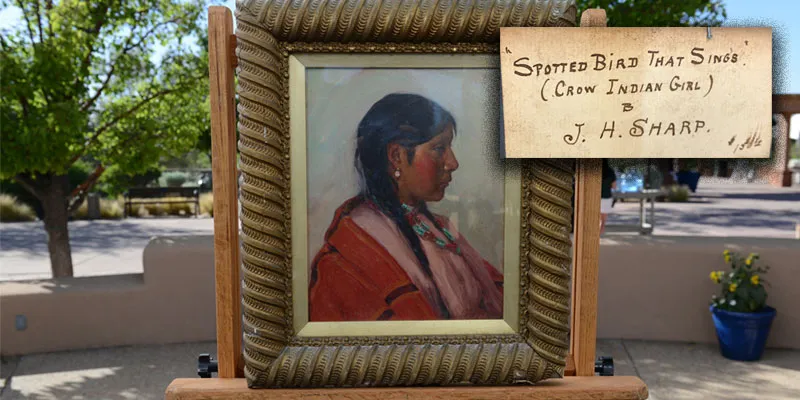Update! Learn New Information on the Joseph Henry Sharp Piece from Santa Fe!
A Joseph Henry Sharp oil portrait appraisal in Santa Fe left our producers with several questions that needed to be solved before we could air the item. Learn how ROADSHOW uncovered new information on this extraordinary painting.

Jan 30, 2023
During ROADSHOW's June 2022 visit to Santa Fe, New Mexico, a guest named Pam brought in an oil portrait that once hung in Andrew Carnegie's mansion in New York City. After Mr. and Mrs. Carnegie had died, their daughter gifted several pieces in the mansion to the building's employees — one such employee being Pam's father-in-law.
Although Tribal Arts appraiser Tony Abeyta was able to identify the painting's artist, Joseph Henry Sharp, through a faint signature on the piece, he noted that the subject, precise date, and other details of the piece would remain unknown without opening up the back of the painting. He suggested to Pam, however, that she rely on the hands of a professional to open it, rather than doing it spontaneously in front of ROADSHOW cameras.
Off camera, Abeyta told Pam that he believed the subject of the portrait to be Leaf Down, a Taos Pueblo Indian girl. Yet, since the back of the painting had not been opened at ROADSHOW, there were still several questions left to be answered.
In the fall of 2022, after the Santa Fe event, ROADSHOW did some further digging. After a producer found a record of Andrew Carnegie purchasing a Sharp painting in 1900, ROADSHOW contacted the Couse-Sharp Historic Site, a research center and museum facility dedicated to the early Taos artists, and spoke to the executive director/curator there, Davison Koenig, to learn more information and determine if the ca. 1900 Sharp painting in question was Pam's, or just one of the many Sharp pieces in Carnegie's collection.
According to Koenig, Pam's painting was most likely done between 1900 and 1910. As Koenig explained to ROADSHOW via email: "Sharp is doing a lot of 'ethnographic' portraits with a muted palette during the period [like Pam's]. By the 1920s he is doing more colorful 'genre' paintings of Taos Pueblo models.”
Second, Koenig agreed with Abeyta that the subject of the portrait could be Leaf Down, but perhaps a younger version of the girl.
Finally, in Koenig's research, he discovered a letter purchased by Forrest Fenn, an art dealer and writer from New Mexico, which stated, "In 1900 Carnegie purchased Spotted Bird That Sings from J.H. Sharp."
In conclusion, Koenig believed that the portrait was in fact of Spotted Bird That Sings — yet couldn't say definitively without seeing the back of the painting. Yet, once our producers relayed Davison's findings to Pam, she took the next step to have the painting opened by a professional.
Several weeks later ROADSHOW received an email from Pam with images — she had opened the back of her painting to reveal an inscription: "Spotted Bird That Sings" (Crow Indian Girl) B. J.H. Sharp.
So with that information, ROADSHOW was able to confirm what Koenig had suspected, and what our producers found: the portrait was done in 1900, and the subject and title are Spotted Bird That Sings. Mystery solved!
You can see Pam's photos below.








